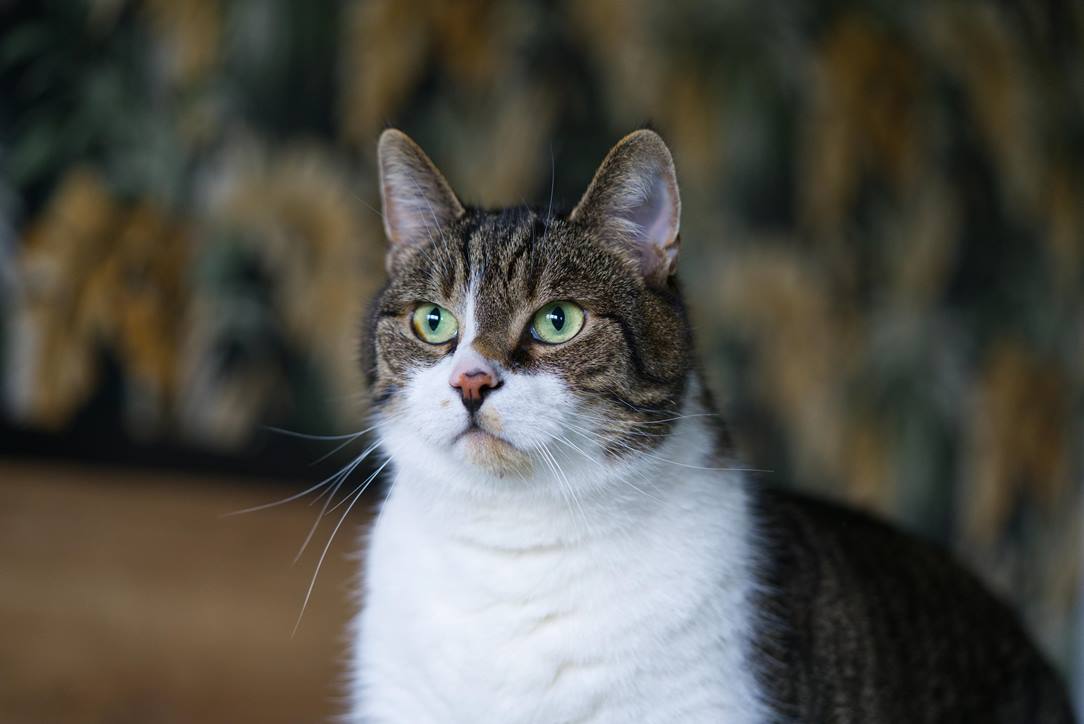In this Article
In today's fast-paced world, many cat owners choose to keep their feline companions indoors to protect them from outdoor dangers such as traffic, predators, and disease. However, this well-intentioned choice often results in a sedentary routine that contributes to a growing epidemic: feline obesity. According to the Association for Pet Obesity Prevention, more than 60% of cats in the United States are overweight or obese, a number that has steadily increased in recent years. This condition not only diminishes a cat's quality of life, but also predisposes them to serious health problems such as diabetes, arthritis and shortened lifespan. Preventing obesity requires a multifaceted approach, including dietary management, regular veterinary checkups and, most importantly, increased physical activity.
One innovative and space-efficient solution that is gaining popularity among pet professionals is the creation of a wall-mounted "cat track" or system of shelves and perches. This setup transforms vertical wall space into a stimulating playground that encourages natural behaviors such as climbing, jumping and exploring. Unlike traditional floor-based cat trees, Wall Tracks take advantage of unused areas in the home, making them ideal for apartments or small living spaces. By mimicking a cat's wild instincts to climb and explore, these structures encourage exercise without forcing unnatural activities. Veterinarians emphasize that such environmental enrichment not only combats weight gain, but also reduces stress and boredom, which can exacerbate overeating. In this article, we'll explore the science behind cat obesity, the benefits of wall-track exercise, a step-by-step guide to organizing one, and expert insights to ensure your pet's health and happiness.
Understanding Cat Obesity: Causes and Risks
Obesity in cats is defined as a body weight 20% or more above the ideal for a cat's breed, age, and size. It's a chronic inflammatory condition that results primarily from an imbalance between calories in and calories out. Indoor cats are particularly susceptible because their environment often lacks the stimulation of the outdoors, resulting in reduced activity levels. Common causes include overfeeding with high-calorie treats, free-feeding practices where food is always available, and lack of play opportunities. Spaying or neutering can also slow the metabolism, increasing the risk if the diet isn't adjusted accordingly.
The health risks are profound. Obese cats are 2.8 times more likely to die between the ages of 8 and 12 than their lean counterparts, with life expectancy potentially reduced by up to two years. Diabetes mellitus is a major concern; obesity contributes to insulin resistance, making cats more susceptible to this lifelong disease. The ASPCA notes that obesity exacerbates pancreatic problems and can lead to abnormal protein deposits, further complicating health. Joint problems such as osteoarthritis result from excess weight stressing bones and ligaments, causing pain and reduced mobility - a vicious cycle that discourages exercise. Respiratory problems, skin infections, and even certain cancers have been linked to fat accumulation. Emotionally, overweight cats may become lethargic, depressed, or aggressive due to discomfort.
Prevention begins with awareness. Veterinarians recommend regular body condition assessments: Feel your cat's ribs - they should be palpable without excess fat cover. If they're hard to see, consult a veterinarian for a customized plan. Diet plays a key role, but exercise is also important. Dr. Joanna Woodnutt, a veterinarian, explains, "Cats will often climb on cat shelves for fun, so they're a great way to encourage exercise, lose weight and build muscle. Indoor enrichment tools such as wall tracks address the root cause by encouraging natural activity, helping to maintain a healthy weight from kittenhood through senior years.
The role of exercise in obesity prevention
Exercise is a cornerstone of obesity prevention because it burns calories, builds muscle, and increases metabolism. For cats, who are obligate carnivores with predatory instincts, physical activity mimics hunting behavior, which is essential for mental and physical health. Regular exercise helps regulate blood sugar, improves cardiovascular function, and increases joint flexibility, counteracting the sedentary traps of indoor living. Studies show that active cats have a lower risk of metabolic disorders, and exercise can add years to their lives.
Experts agree that cats need at least 15-20 minutes of exercise daily, ideally in short bursts to match their natural energy patterns. "Cats naturally engage in short bursts of activity rather than long sessions, so it is recommended to provide toys and games that encourage this type of action," advises VCA Animal Hospitals. For obese cats, starting slow is key; play can be challenging as they tire quickly, but integrating activity with feeding - such as tossing food or using puzzle feeders - builds momentum. "When cats are obese, play can be challenging, and they tend to spend most of their time eating and sleeping. In these cases, it may be helpful to increase the level of activity associated with feeding," the VCA experts note.
Wall-mounted tracks excel here by providing vertical exercise that engages core muscles and improves agility. Unlike flat play, climbing stimulates endorphins and reduces stress eating. The ASPCA recommends activities like chasing laser pointers or hiding treats to stimulate prey drive, but wall systems offer passive enrichment - cats explore independently, burning calories without constant owner involvement. "Ideally, or eventually, you and your cat will get about 20 minutes of activity each day," they suggest, which is achievable with a well-designed run. Environmental modifications, such as placing food on elevated perches, encourage daily climbing. According to the Association for Pet Obesity Prevention, the use of indoor chase feeders and rotating food locations promotes exercise and mental stimulation, preventing overeating due to boredom. In multi-cat homes, tracks reduce territorial stress by providing personal space, which indirectly aids in weight control.
What is a cat wall run?
A cat wall track, also known as a cat shelf, perch, or "cat highway," is a customizable system of wall-mounted platforms, bridges, and ramps designed to create a vertical pathway for cats. Inspired by felines' arboreal instincts - wild cats climb trees for safety and hunting - these units turn blank walls into adventure zones. Basic components include floating shelves, hammocks, tunnels and scratching posts secured to studs for stability.
Unlike bulky cat trees, wall-mounted cat trees save floor space and blend in with home décor. They can span rooms and connect high vantage points such as windowsills or cabinets. Materials range from wood and carpet for traction to modern acrylic for aesthetics. Catastrophic Creations experts recommend 12-16 inches horizontally and 12-18 inches vertically for safe jumps, ensuring accessibility for all ages. The benefits go beyond exercise: They provide hiding places to reduce anxiety, Dr. Woodnutt points out, which reduces destructive behaviors. For obesity prevention, the constant lure of elevation encourages spontaneous activity, turning lazy lounging into dynamic play.
How to organize and install a cat wall-track
Organizing a cat wall garden starts with an assessment. Evaluate your cat's age, weight, and mobility - kittens need challenging jumps, while seniors prefer gentle ramps. Measure wall space, aiming for stable areas such as over studs. Budget varies: Do-it-yourself options cost $50-$200, while pre-built kits run $100-$500.
Installation steps:
-
Plan the layout: Sketch a design with entry points at ground level, rising to heights of 6-7 feet. Include variety: shelves for resting, bridges for walking, and perches near windows for bird-watching. Expert Cat Care suggests incorporating tunnels and multi-level trees along walls for enhanced play.
-
Gather materials: Use heavy-duty shelves rated for 50-70 pounds, such as Cat Clouds models, to support larger cats. Tools include a stud finder, level, drill, anchors and brackets. Cover surfaces with sisal or carpet for traction.
-
Install securely: Locate studs for anchors to prevent collapse. Start low and test for stability before adding height. Reddit homeowners advise using floor-supported shelving if the walls are weak and secured to prevent tipping.
-
Introduce gradually: Entice with treats or catnip. Monitor usage and adjust based on preference.
-
Integrate into routine: Place feeders or toys on tracks to link activity to meals, as the VCA recommends.
DIY ideas from PetsRadar include upcycling crates or IKEA hacks for inexpensive perches. Consult a vet if your cat is overweight to make sure the setup is appropriate for her fitness level.
Safety Considerations and Maintenance
Safety is paramount. Use non-toxic materials, avoid sharp edges, and make sure there are gaps to prevent entrapment. For heavy cats, reinforce with additional brackets. Regular inspections for wear are essential. Clean surfaces weekly to avoid allergens. If your cat shows disinterest or distress, adjust with ramps or consult a behaviorist.
Bottom Line
A wall-mounted cat tree is more than just a decoration-it's a proactive tool against obesity that promotes a healthier, happier pet. By following the advice of experts like Dr. Woodnutt and organizations like the VCA and ASPCA, you can create an enriching environment that naturally combats weight gain. Start small, watch your cat's reaction, and enjoy the bond that comes from play. With consistent effort, you'll help your feline friend thrive and prove that prevention is the best medicine.

